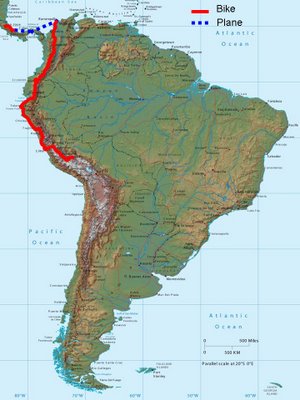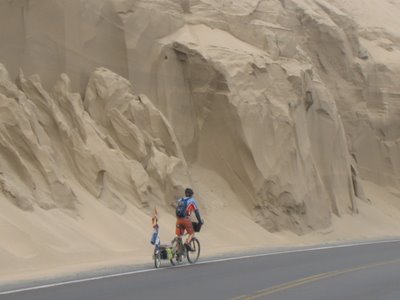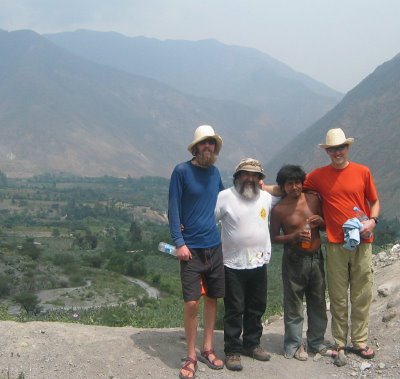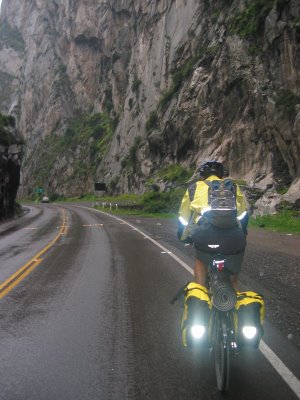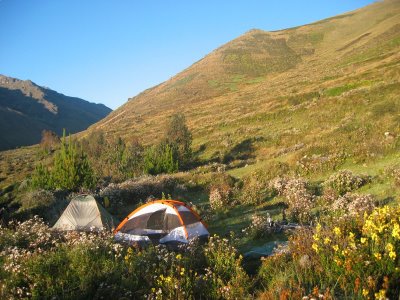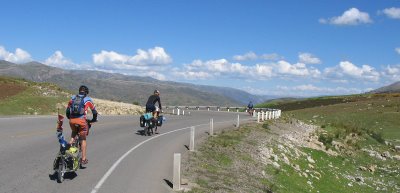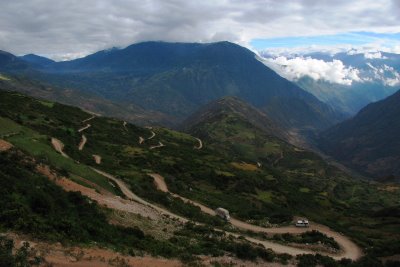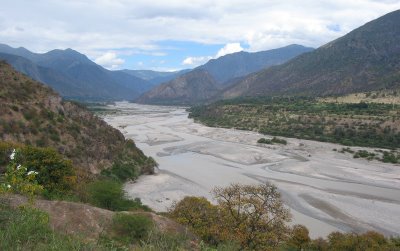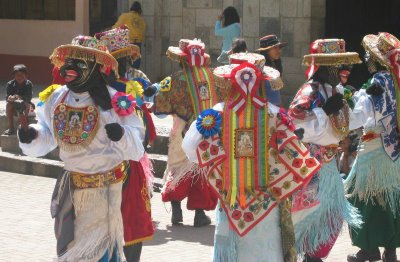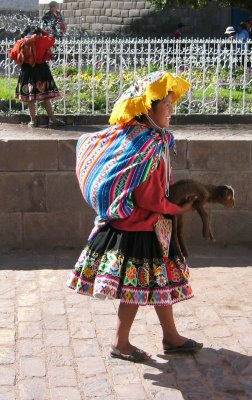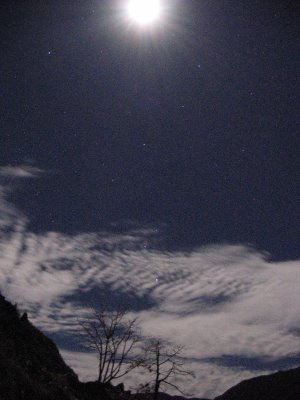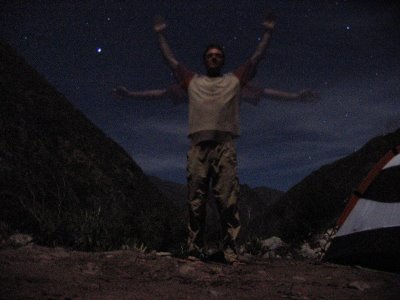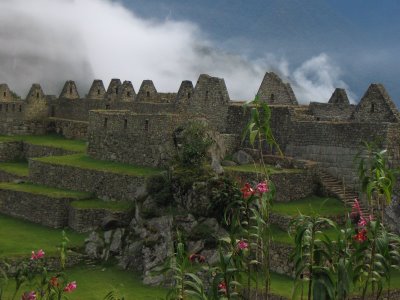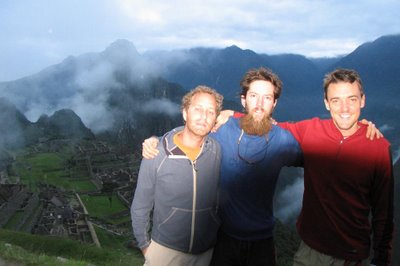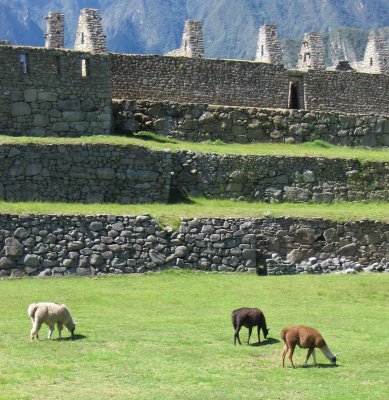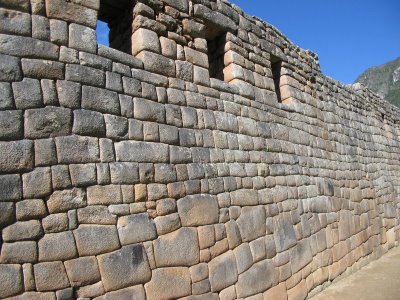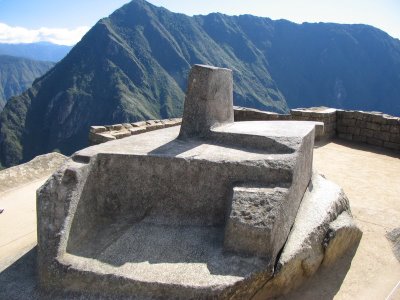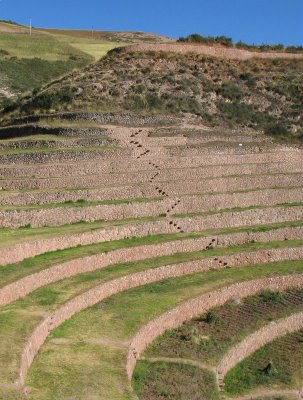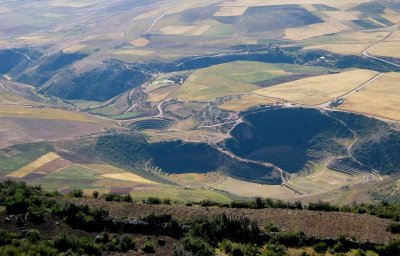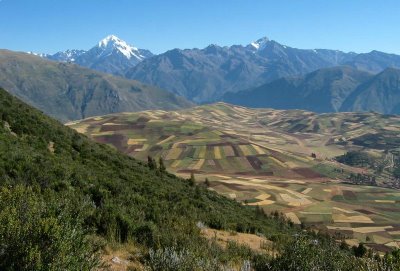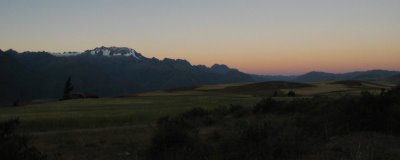Two Paths Diverged on the Salt
 Run into a town mid-afternoon? Mission the first: fruit. Death by bonking staved off once again.
Run into a town mid-afternoon? Mission the first: fruit. Death by bonking staved off once again.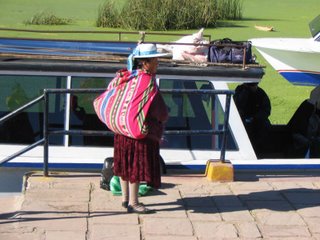 A Quechua woman waiting for a boat. Notice the bizzare algae covered water that looks like you could walk on it. (I tried, you can't.)
A Quechua woman waiting for a boat. Notice the bizzare algae covered water that looks like you could walk on it. (I tried, you can't.) Even more bizzare are these islands, which float in the middle of lake Titicaca. Here you can see local women collecting and bundling reeds to dry. Later they will add these reeds to the top layer of the island, which is constantly sinking as the bottom layers rot away and new layers are added to the top.
Even more bizzare are these islands, which float in the middle of lake Titicaca. Here you can see local women collecting and bundling reeds to dry. Later they will add these reeds to the top layer of the island, which is constantly sinking as the bottom layers rot away and new layers are added to the top.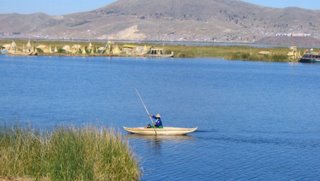 They build their boats out of the same reeds.
They build their boats out of the same reeds.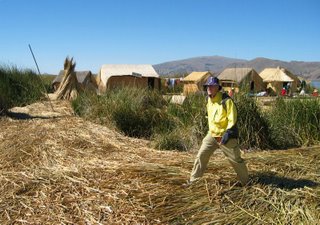 They are fishermen, but these days they get their primary income by collecting entrance fees from silly tourists who want to bounce around on their plushy waterbed islands.
They are fishermen, but these days they get their primary income by collecting entrance fees from silly tourists who want to bounce around on their plushy waterbed islands. And even on a floating reed island, those tourists gotta have a john!
And even on a floating reed island, those tourists gotta have a john!Being a touring cyclist is a pretty sweet lifestyle. Everybody loves you, everybody wants to talk to you and feed you and show you around their town. They don't mind if you sleep in their yard and dig a toilet in their farm. You're always going places and seeing things, you get to be outside all the time with sun and fresh air and your blood flows with enthusiasm. You have no responsibilities, no deadlines, no bedtime. (Though admittedly you’re usually out cold by 8…) You do whatever you want, whenever you want. When you get hungry, you can eat as much ice cream and chocolate as you want. Heck, if you feel like it you can eat lard with a spoon and still lose weight. And when you are tired, you can sleep 12 hours without feeling lazy. Cause hey, you rode eighty kilometros today, and you're gonna ride another eighty tomorrow, and the next day, and the day after that. Your calves are tanned and sinuous, and your thighs work like pistons.
 Sorry, I can't resist a good shot of hills and sky and road.
Sorry, I can't resist a good shot of hills and sky and road. Quechua sheep herders were ubiquitous in the highlands of Bolivia.
Quechua sheep herders were ubiquitous in the highlands of Bolivia.The one thing, though, is that you're constantly having to go somewhere else. You can do anything you want, anywhere you want, except stay. That's the one thing that's not allowed.
 Just liked all the blue in this shot. I was eating an ice cream that I bought from the old woman, and probably asking directions from the guy. He was probably saying "Oh, it's easy, no problem, straight ahead! You can't miss it! Where did you say you were going again? It doesn't matter, it's that way. Just go straight!"
Just liked all the blue in this shot. I was eating an ice cream that I bought from the old woman, and probably asking directions from the guy. He was probably saying "Oh, it's easy, no problem, straight ahead! You can't miss it! Where did you say you were going again? It doesn't matter, it's that way. Just go straight!"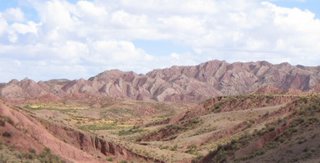 More hills and sky. I can't get enough of it folks. It's worth clicking on to look at closer.
More hills and sky. I can't get enough of it folks. It's worth clicking on to look at closer.If I could think of a way to be a touring cyclist at home, that would be ideal. I could pack up my panniers in the garage each morning and head out around seven. I could leave town to the east and catch breakfast with Dawn in Tijeras, then head north around the Sandia Mountains and over to Placitas. I could have lunch with Bethany on the north side of town, and then head south down the river trail. I could pop into old town for some culture and to buy some souvenirs. Then on my way home in the evening, I could stop by Craig and Brenda's for dinner. I'd get home in time to go back out for some form of construction with Daniel, you know, tiling the closet ceilings with decorative terra cotta and what-not, or to get beat at cards by Grafton, play some Parcheesi with Craig and Brenda, or shoot some billiards with Mathias and Jens. Then I could do some writing in my rocking chair, eat a half gallon of Moosetracks, and hit the sack in my back yard.
 A river got in our way in the high desert. Actually a few of them did. You can't tell, but there's ice in there, and the water's moving fast! We got across ok, but it HURT!
A river got in our way in the high desert. Actually a few of them did. You can't tell, but there's ice in there, and the water's moving fast! We got across ok, but it HURT! That was the last we saw of water for quite some time, as we set out across the desert in search of the mighty Bolivian salt flats. Sometimes we were just slogging through sand with a compass bearing.
That was the last we saw of water for quite some time, as we set out across the desert in search of the mighty Bolivian salt flats. Sometimes we were just slogging through sand with a compass bearing.“Where have you come from?” they would ask me in the street, in the cafes, and on the UNM campus, stupefied, in awe of my heavily loaded bike and my tanned, sinuous calves.
 Other times we followed llama tracks...
Other times we followed llama tracks... made by these guys! Sometimes we inadvertently herded them for many kilometers, since they would keep their distance as we approached. Hope the owner could still find them later!
made by these guys! Sometimes we inadvertently herded them for many kilometers, since they would keep their distance as we approached. Hope the owner could still find them later!From Albuquerque," I would say. "I started in June."
 The owner of those llamas probably lived here. We came across these in the absolute middle of nowhere- nothing for many kilometers in any direction.
The owner of those llamas probably lived here. We came across these in the absolute middle of nowhere- nothing for many kilometers in any direction. I couldn't resist a picture of this little chapel in a dusty little village. You're looking at about half of that village here in this photo.
I couldn't resist a picture of this little chapel in a dusty little village. You're looking at about half of that village here in this photo.“Wow, 2 months on a bike! Man, your thighs move like pistons! So you're just getting back huh? Where all have you gone?”
 Again in the dead center of nowhere, Bolivia, we started seeing these strange houses with no roads or paths to them, and had to investigate.
Again in the dead center of nowhere, Bolivia, we started seeing these strange houses with no roads or paths to them, and had to investigate.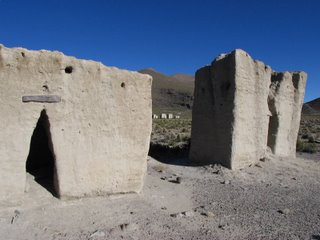 From up close they were even stranger. Not much room to move around in there. What could they be for?
From up close they were even stranger. Not much room to move around in there. What could they be for?“Well, I've been to Tijeras 58 times, and to Placitas, and Rio Rancho. I only went to Rio Rancho 56 times though, because twice I was running a little late for dinner and just hopped on the bus to save time. I eat dinner with Craig and Brenda every night, you see, and Brenda’s a strict one with the clock.”
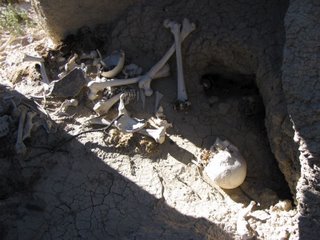 Then we poked our heads inside and it all became clear. These guys didn't need much wiggle space! The mud that made up the back of this one had melted away in the rain, which is how I got this picture.
Then we poked our heads inside and it all became clear. These guys didn't need much wiggle space! The mud that made up the back of this one had melted away in the rain, which is how I got this picture.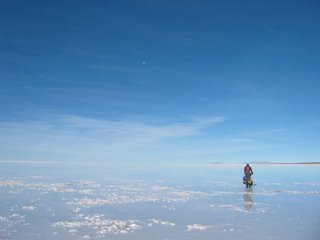 Then, out of the seemingly infinite desert spilled the Salar de Coipasa, one of the worlds largest salt flats. Part of it was covered in a couple inches of water.
Then, out of the seemingly infinite desert spilled the Salar de Coipasa, one of the worlds largest salt flats. Part of it was covered in a couple inches of water.“Oh, I see. Wow. Hmm. That’s interesting. So hey, what do you need all those panniers for if you go home every night?”
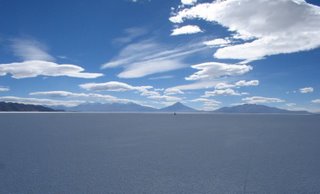 The rest of it was just a massive plan of hard, flat, crystalline salt.
The rest of it was just a massive plan of hard, flat, crystalline salt. A brief interlude on washboards and sand...
A brief interlude on washboards and sand...“Well, I’m a touring cyclist! I’ve got my tent and food and sleeping bag and rain gear, you know, it all adds up.”
 then the Salar de Uyuni, even bigger! 160 kilometers across, it took us three (fairly leisurely) days of riding West-Southwest to get to the other side. Sometimes it was rough and crystalline.
then the Salar de Uyuni, even bigger! 160 kilometers across, it took us three (fairly leisurely) days of riding West-Southwest to get to the other side. Sometimes it was rough and crystalline. Sometimes it was smooth with polygonal crack patterns.
Sometimes it was smooth with polygonal crack patterns.“Oh yeah, of course. That’s cool. But hey, uh, don’t you just mooch food off your friends? Isn’t it sunny 360 days a year in Albuquerque? Don’t you sleep at your house?”
 There was an island in the middle,
There was an island in the middle,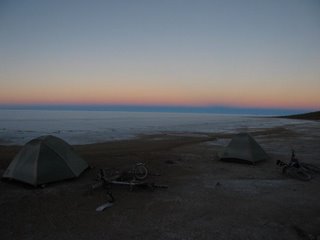 where we slept.
where we slept.“Yeah, of course. But I’m trying to keep it real, you know? I’m a touring cyclist! So I carry my food, I only shower once a week, and I sleep in my back yard. Got everything I need right here in my panniers.”
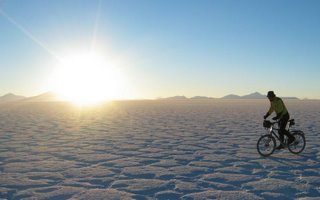 Other times it was just plain bumpy.
Other times it was just plain bumpy.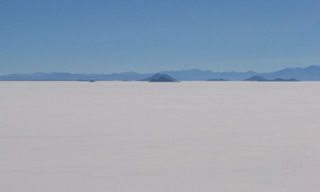 It was always beautiful,
It was always beautiful,“Oh. Hmm. Yeah, ok. Listen, I gotta get going...”
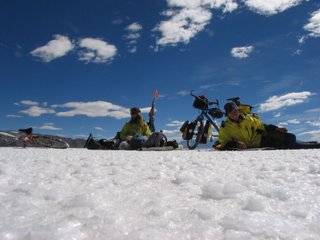 and there was plenty of room to spread out and enjoy it. Rob and I had a great time on this trip.
and there was plenty of room to spread out and enjoy it. Rob and I had a great time on this trip. But all good things must come to an end, and for me it was time. So after nearly 6 months of parallel tracks, our paths diverged.
But all good things must come to an end, and for me it was time. So after nearly 6 months of parallel tracks, our paths diverged. The final damage: maybe 7000km or so. It's hard to say for sure, since my odometer broke part way through. What a trip. Thanks for inviting me Rob. Awesome.
The final damage: maybe 7000km or so. It's hard to say for sure, since my odometer broke part way through. What a trip. Thanks for inviting me Rob. Awesome.So anyway, yeah, I guess that wouldn’t really work out so great. But I like my friends, my job, and green chilli. So I guess I’ll just have to settle for pale and fleshy calves. I’m going home! Of course, nothing’s ever simple with me, and it’s going to take me a while yet to get there. But in January I plan to be back in Albuquerque, building lasers, playing Parcheesi, and tiling closet ceilings. And I’m pretty darn excited about it.
Thanks for coming folks!
THE END
